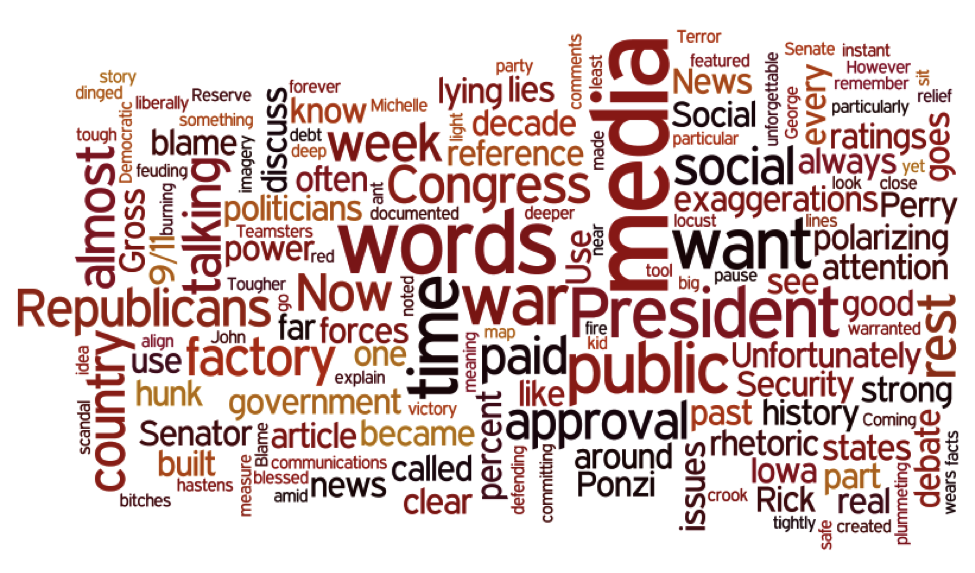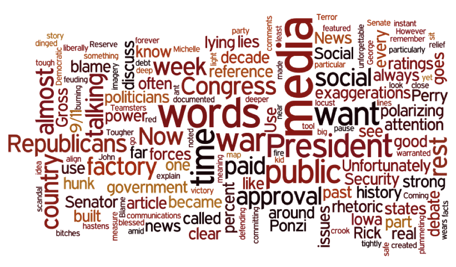Rhetoric – Communications Lessons from the Failures of Political Posturing
Sep 26, 2011 Beth Monaghan
As we gratefully evacuate a decade that was marked more by words that conveyed the unspeakable sadnesses of 9/11 and Katrina than the triumphant victory of Captain Sullenbeger (although we welcomed that blessed pause in the heartache that made us believe in miracles, if only briefly), we emerge divided.
In his article, “Coming Apart,” George Packer noted that we entered into 9/11 just after the 2000 election when the news media, for the first time, color-coded the country into blue and red states. The ensuing decade featured rhetoric that has polarized the country.
Polarization is a powerful communications tool for fostering interest. It works almost every time. And an appropriate degree of controversy is critical for breaking through. However, when it goes too far, it does damage that has staying power. Just last week Professor Elizabeth Warren, in her bid to unseat Senator Scott Brown, went viral because of controversial, polarizing and therefore memorable comments that are yet to be judged by the clear rear view of history. But they are certainly getting attention (as of today, she has almost half a million views on YouTube):
“There is nobody in this country who got rich on his own. Nobody. You built a factory out there — good for you. But I want to be clear. You moved your goods to market on the roads the rest of us paid for. You hired workers the rest of us paid to educate. You were safe in your factory because of police forces and fire forces that the rest of us paid for… Now look, you built a factory and it turned into something terrific, or a great idea — God bless. Keep a big hunk of it. But part of the underlying social contract is you take a hunk of that and pay forward for the next kid who comes along.”
The foibles, squabbles, dogmatic battles and personal shortcomings of politicians provide some instructive examples of tactics to avoid when committing words to the public record. Consider these lessons from recent history (and the unforgettable past) about what not do:
- Assign blame. This week, Congress is feuding over approval of a disaster relief measure and Democratic Senate Majority Leader Harry Reid said, “Do they (Republicans) want the government to shut down? Do they want FEMA to close?” In the UK, the government blamed social media for the riots that shook London this past summer. During the debt ceiling crisis, Republicans and Democrats spent more time talking about who was to blame than about how to fix it. Now the President and Congress are suffering from dismal approval ratings (the approval rating is 15 percent for Congress and 40 percent for the President). Blame trading only hastens plummeting approval ratings and it almost always looks weak.
- Use polarizing language liberally. U.S News & World Report had an article last week about Americans’ distrust of the news media – CNN and FOX in particular due to their bias. Rick Perry called Federal Reserve Chairman Ben Bernanke a “traitor” and Teamsters President Jim Hoffa called Republicans “sons of bitches.” It’s tough to sit down and talk like gentlemen with those fighting words under your belt. Now, if they are warranted, strong words pack an incredible punch when used sparingly. But used widely they have the opposite effect: they become part of your public repertoire and lose meaning. Your credibility suffers. Remember President Bush’s “rid the world of evil doers?” I know you do. The tag lines of the “War on Terror” were repeated far too often and became meaningless. Tougher issues demand specificity to inspire confidence after the emotion wears off.
- Use war imagery (unless you’re talking about a real war). During every debate, we are guaranteed to hear at least one war reference: candidates will discuss their “battle plans,” draw on the support of their “war chests,” and explain how they will use our votes as “ammunition.” Recall Sarah Palin’s cross-hairs map of states for Republican focus that was quickly removed after the attack on Congresswoman Giffords. As we’ve seen, this kind of rhetoric can go wrong in an instant.
- Lie. This one is obvious and I wish it did not have a place here. Unfortunately, the undertow of lying amid the white heat of public questioning is often stronger than will power. We know the now famous politicians’ lies of our time: Nixon’s “I am not a crook,” Clinton’s “I did not have relations with that woman,” John Edwards’ “I am not the father of any baby.” The list goes on. Today, social media has amplified the uncovering of lies. We can point to Senator Weiner and more recently, State Representative Hinkle. Lies pulled each of these figures deeper into scandal. So deep in fact, that the lying became worse than the actual disgraced act. Add in media coverage, and “it’s like burning an ant with a magnifying glass.”
- Grossly exaggerate. I’m not talking about embellishing or framing in the best light. Gross exaggerations wind truth and fiction so tightly that it’s hard to see the space between them. Once someone does (and they always do), the person’s word is forever tainted. Michelle Bachman has been dinged in The New Yorker about her family’s strong Iowa roots: a story of perseverance, complete with overcoming flooding, drought and locust infestation. The reality, however, is that her facts and dates did not align and it happened near Iowa, not actually in it. Rick Perry is also defending his reference to Social Security as a Ponzi scheme. This has created debate within his own party that has drawn attention away from the issue of Social Security and toward the Ponzi Scheme statement (see Dick Cheney’s ABC News interview). Lesson? Gross exaggerations might sound good in the moment, but soon they will overtake the real issues you want to discuss.
In the end, we must all remember that words have the ability to convince and repel, and regardless of the outcome, they are etched in the public consciousness more deeply for being written…particularly when they are reported in the media and documented by Google.


.png)




